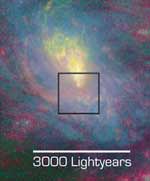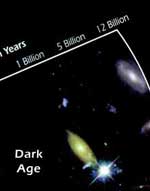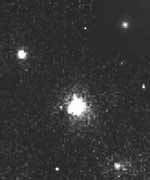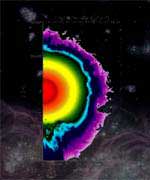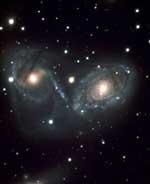
Image credit: Fermilab
With the first data from their underground observatory in Northern Minnesota, scientists of the Cryogenic Dark Matter Search have peered with greater sensitivity than ever before into the suspected realm of the WIMPS. The sighting of Weakly Interacting Massive Particles could solve the double mystery of dark matter on the cosmic scale and of supersymmetry on the subatomic scale.
The CDMS II result, described in a paper submitted to Physical Review Letters, shows with 90 percent certainty that the interaction rate of a WIMP with mass 60 GeV must be less than 4 x 10-43 cm2 or about one interaction every 25 days per kilogram of germanium, the material in the experiment’s detector. This result tells researchers more than they have ever known before about WIMPS, if they exist. The measurements from the CDMS II detectors are at least four times more sensitive than the best previous measurement offered by the EDELWEISS experiment, an underground European experiment near Grenoble, France.
“Think of this improved sensitivity like a new telescope with twice the diameter and thus four times the light collection of any that came before it,” said CDMS II cospokesperson Blas Cabrera of Stanford University. “We are now able to look for a signal that is just one-fourth as bright as any we have seen before. Over the next few years, we expect to improve our sensitivity by a factor of 20 or more.”
The results are being presented at the April Meeting of the American Physical Society on May 3 and 4 in Denver by Harry Nelson and graduate student Joel Sanders, both of the University of California-Santa Barbara, and by Gensheng Wang and Sharmila Kamat of Case Western Reserve University.
“We know that neither our Standard Model of particle physics nor our model of the cosmos is complete,” said CDMS II spokesperson Bernard Sadoulet of the University of California at Berkeley. “This particular missing piece seems to fit both puzzles. We are seeing the same shape from two different directions.”
WIMPs, which carry no charge, are a study in contradictions. While physicists expect them to have about 100 times the mass of protons, their ghostly nature allows them to slip through ordinary matter leaving barely a trace. The term “weakly interacting” refers not to the amount of energy deposited when they interact with normal matter, but rather to the fact that they interact extremely infrequently. In fact, as many as a hundred billion WIMPs may have streamed through your body as you read these first few sentences.
With 48 scientists from 13 institutions, plus another 28 engineering, technical and administrative staffers, CDMS II operates with funding from the Office of Science of the U.S. Department of Energy, from the Astronomy and Physics Divisions of the National Science Foundation and from member institutions. The DOE’s Fermi National Accelerator Laboratory provides the project management for CDMS II.
“The nature of dark matter is fundamental to our understanding of the formation and evolution of the universe,” said Dr. Raymond L. Orbach, Director of DOE’s Office of Science. “This experiment could not have succeeded without the active collaboration of the DOE’s Office of Science and the National Science Foundation.”
Michael Turner, Assistant Director for Math and Physical Sciences at NSF, described identifying the constituent of the dark matter as one of the great challenges in both astrophysics and particle physics.
“Dark matter holds together all structures in the universe-including our own Milky Way-and we still do not know what the dark matter is made of,” Turner said. “The working hypothesis is that it is a new form of matter-which, if correct will shed light on the inner workings of the elementary forces and particles. In pursuing the solution to this important puzzle, CDMS is now at the head of the pack, with another factor of 20 in sensitivity still to come.”
Dark matter in the universe is detected through its gravitational effects on all cosmic scales, from the growth of structure in the early universe to the stability of galaxies today. Cosmological data from many sources confirm that this unseen dark matter totals more than seven times the amount of ordinary visible matter forming the stars, planets and other objects in the universe.
“Something out there formed the galaxies and holds them together today, and it neither emits nor absorbs light,” said Cabrera. “The mass of the stars in a galaxy is only 10 percent of the mass of the entire galaxy, so the stars are like Christmas tree lights decorating the living room of a large dark house.”
Physicists also believe WIMPs could be the as-yet unobserved subatomic particles called neutralinos. These would be evidence for the theory of supersymmetry, introducing intriguing new physics beyond today’s Standard Model of fundamental particles and forces.
Supersymmetry predicts that every known particle has a supersymmetric partner with complementary properties, although none of these partners has yet been observed. However, many models of supersymmetry predict that the lightest supersymmetric particle, called the neutralino, has a mass about 100 times that of the proton.
“Theorists came up with all of these so-called ‘supersymmetric partners’ of the known particles to explain problems on the tiniest distance scales,” said Dan Akerib of Case Western Reserve University. “In one of those fascinating connections of the very large and the very small, the lightest of these superpartners could be the missing piece of the puzzle for explaining what we observe on the very largest distance scales.”
The CDMS II team practices “underground astronomy,” with particle detectors located nearly a half-mile below the earth’s surface in a former iron mine in Soudan, Minnesota. The 2,341 feet of the earth’s crust shields out cosmic rays and the background particles they produce. The detectors are made of germanium and silicon, semiconductor crystals with similar properties. The detectors are chilled to within one-tenth of a degree of absolute zero, so cold that molecular motion becomes negligible. The detectors simultaneously measure the charge and vibration produced by particle interactions within the crystals. WIMPS will signal their presence by releasing less charge than other particles for the same amount of vibration.
“Our detectors act like a telescope equipped with filters that allow astronomers to distinguish one color of light from another,” said CDMS II project manager Dan Bauer of Fermilab. “Only, in our case, we are trying to filter out conventional particles in favor of dark matter WIMPS.”
Physicist Earl Peterson of the University Minnesota oversees the Soudan Underground Laboratory, also home to Fermilab’s long-baseline neutrino experiment, the Main Injector Neutrino Oscillation Search.
“I’m excited about the significant new result from CDMS II, and I congratulate the collaboration,” Peterson said. “I’m pleased that the facilities of the Soudan Laboratory contributed to the success of CDMS II. And I’m especially pleased that the work of Fermilab and the University of Minnesota in expanding the Soudan Laboratory has resulted in superb new physics.”
As CDSMII searches for WIMPs over the next few years, either the dark matter of our universe will be discovered, or a large range of supersymmetric models will be excluded from possibility. Either way, the CDMS II experiment will play a major role in advancing our understanding of particle physics and of the cosmos.
The CDMS II collaborating institutions include Brown University, Case Western Reserve University, Fermi National Accelerator Laboratory, Lawrence Berkeley National Laboratory, the National Institutes of Standards and Technology, Princeton University, Santa Clara University, Stanford University, the University of California-Berkeley, the University of California-Santa Barbara, the University of Colorado at Denver, the University of Florida, and the University of Minnesota.
Fermilab is a DOE Office of Science national laboratory operated under contract by Universities Research Association, Inc.
Original Source: Fermilab News Release


